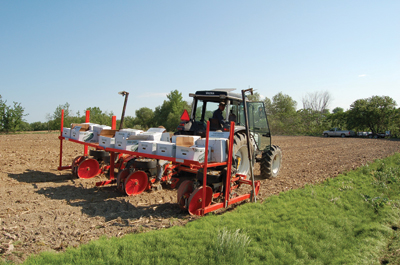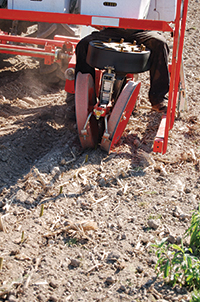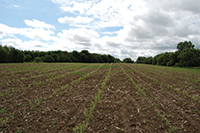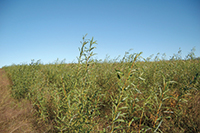
Grow Your Own Feedstock
August 22, 2011
By Martine Frigon
It can be difficult to decide on the right type of biomass heating system to suit a particular location and application.

|
| Willow cuttings are planted using a modified cabbage planter.
|
It can be difficult to decide on the right type of biomass heating system to suit a particular location and application. So to help its members, the Quebec Union of Greenhouse Producers (Le Syndicat des producteurs en serre du Québec) launched a biomass pilot project with one of its growers. The project will showcase greenhouse heating using biomass from a willow plantation, with open houses and films taken during the project provided as educational materials.

|
|
Verrier Greenhouses (Serres Verrier), located at St-Joachim-de-Courval, about 80 km east of Montreal, is the model site for the pilot project. After obtaining a horticulture degree in 1984, owner Luc Verrier built a small greenhouse on the 50-ha property beside his parents’ home. He began growing zucchini and beans, but soon switched to tomatoes, cucumber, and lettuce, which he now grows in 14 greenhouses totalling 2,500 m2. Verrier’s clientele has grown over the years, and he now supplies nearly 40 regional supermarkets and food stores such as the Metro and IGA chains, within about 100 km of his operation.
Because energy costs constitute a large proportion of business expenses, the greenhouse association wants to demonstrate the utility of woody biomass as a viable alternative energy source. As well as installing and evaluating the performance of a biomass boiler, the project aims to establish a plantation of fast-growing willow on the producer’s land and develop an integrated supply of willow and residues from nearby forestry operations. Verrier Greenhouses was chosen to host the pilot project, partly because of the availability of land to establish a feedstock plantation.
Willow plantation
“The willow takes only three years to become ready to use as biomass and is commonly used in Finland and Britain,” says Jean Gobeil of Jean Gobeil and Associates, who is co-ordinating the project. To become self-sufficient in feedstock production, Verrier planted 160,000 willow cuttings on about 10 ha of his land in June 2010, followed by an additional 10 ha in spring 2011.
Agro Énergie, a company that specializes in willow cropping, provided the willow cuttings and planted them using a modified cabbage planter, according to company president Francis Allard. They fertilized with manure prior to planting and will fertilize again after the first harvest in three years time. It cost about $2,558/ha to establish the plantation, including purchasing the cuttings, planting, maintenance, harvesting, and applying fertilizer and herbicide.
Two months after the first planting, the willows were already 35 cm tall, with a 91% survival rate. Just one month later, some were up to 2 m tall. The plantation will produce an average of 200 dry tons of wood chips annually starting three years after planting.
Verrier expects to harvest the first willow in 2013. Meanwhile, he uses non-merchantable wood supplied by surrounding woodlot owners to feed the new boiler. Verrier receives a truckload of roundwood every two weeks, which he chips using a second-hand Morbark 248 chipper that he bought in 2010. The chipped wood is then stored under cover in a shed. Currently with only one shed, Verrier plans to build two additional ones next fall to store the quantity of willow that he needs to meet the greenhouses’ energy requirements for an entire year.

|
|

|
|
| Above: One month after planting, the willow cuttings are well established. Below: Three months after planting, some are already two metres tall. |
Boiler installation
Prior to converting to the new biomass system, Verrier used two small wood furnaces, an oil furnace, and two 18,900-L hot water storage tanks to heat the greenhouses. Although he is not the first greenhouse operator in Quebec to use a biomass system—there could be more than 20, according to Gobeil—this is the first that will use wood residues and willow.
In operation since December 2010, the new biomass system was built by Transfab Énergie, located in St-Nicolas, Quebec. “We installed a heating system of 55 hp (550 kW), which is enough for this location. In addition, we had to complete this system with a 34,200-L hot water storage tank that stores the surplus heat in periods of relatively low heating,” says Bernard Blouin, engineer for the manufacturer. “A 20-tonne silo feeder has also been built, which provides self-sufficiency for seven days,” he adds. The boiler controls were set up by subcontractor Controles CEI, located in Victoriaville, and the system includes an air filtration system and a dust and ash collector.
The biomass boiler is designed to burn relatively wet feedstock. “We needed a system that could run with forest residues but also with willow—that means a biomass that has a humidity rate of 35%,” Gobeil says. The estimated payback time for such an investment should be “not more than one-and-a-half years for a greenhouse of less than 3,000 m2. Otherwise, the move is not profitable,” he says.
The total costs of the pilot project could be up to $540,000, including the furnace and boiler system itself and all the other parts of the project, such as documentation that will be available for the greenhouse association’s members. “In addition to the Quebec Union of Greenhouse Producers’ participation, the Quebec Ministry of Agriculture, Fisheries, and Food (MAPAQ) contributed $213,000, and another provincial organization, l’Agence de l’efficacité énergétique (Energy Efficiency Agency), contributed $205,000 from its biomass conversion and fuel consumption reduction programs. The balance was paid by Verrier and the Union,” explains Gobeil.
Sensors have been installed to measure the water temperature in the greenhouses and at the boiler. Already with the new system, Verrier has seen an improvement in temperature control, and thus, in crop production. “I harvested at least a week in advance compared to last year,” he says. “The system, along with the sensors, controls the temperature in each unit. I am really confident that this move will be a positive experience.”
Print this page